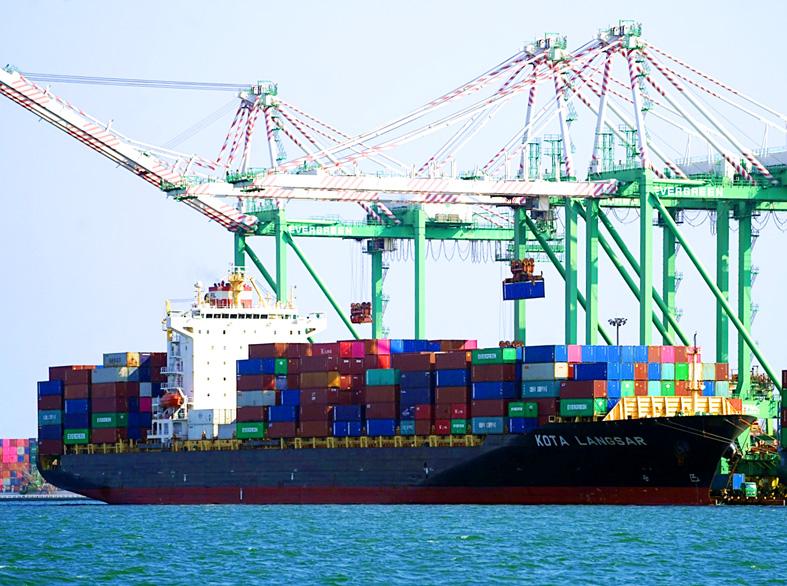Export orders grew for a 16th straight month annually to US$53.75 billion last month, the Ministry of Economic Affairs reported yesterday.
The figure was up 2.8 percent from May and 31.1 percent from a year earlier, it added.
Despite the COVID-19 pandemic, robust global demand for tech products and high commodity prices made last month’s orders the strongest June level on record, Department of Statistics Director Huang Yu-ling (黃于玲) told a news conference in Taipei.

Photo: CNA
For the second quarter, export orders reached US$160.96 billion, up 8 percent from the first quarter and 35.9 percent from a year earlier. That brought orders for the first half of the year to US$309.92 billion, an annual increase of 39.2 percent, the highest for the same period on record, the ministry said.
“The stay-at-home economy has not abated,” Huang said. “The demand for laptops, graphic cards and storage devices remains strong.”
Orders for information and communications technology products grew 6.9 percent year-on-year to US$13.89 billion last month, and those for electronics items increased 36.5 percent to US$16.79 billion, bolstered by demand for 5G and high-performance computing applications, the ministry said.
Orders for optical products expanded 42.7 percent year-on-year to US$2.74 billion last month, driven by demand from China and Hong Kong, it said.
Taiwanese exporters also benefited from the US and EU infrastructure projects, as base metal orders surged 81.8 percent to US$3.32 billion and orders for mechanical products advanced 40 percent to US$2.26 billion, the ministry said.
Orders for plastics and petrochemicals rose 57.5 percent to US$2.6 billion last month, thanks to rising oil prices and increasing demand, while chemical product orders expanded 43.2 percent to US$1.87 billion, it said.
The US was again the biggest source of export orders, which rose 7.8 percent month-on-month and 24 percent year-on-year to US$16.48 billion, it said.
China followed at US$14.43 billion, up 1.5 percent month-on-month and 36.7 percent year-on-year, and the EU came in third with orders of US$9.28 billion, down 2.5 percent month-on-month, but up 24.3 percent year-on-year.
While the pandemic remains an uncertainty, the steady increase in global vaccinations and a pickup in basic infrastructure projects lend confidence to a recovery, Huang said.
“The pace of global economic recovery is picking up, and we are entering into the second half of the year, the strong season for consumer electronic products,” Huang said. “We can expect export orders to stay strong.”
A recent survey of Taiwanese businesses showed that 20.5 percent expect fewer orders for this month, 19.5 percent expect more orders and 60.1 percent expect orders to be flat, the ministry said.
The ministry forecast export orders for this month of US$52.7 billion to US$54.2 billion, down 1.9 percent to 0.9 percent month-on-month, but up 15.7 to 18.9 percent year-on-year.

UNCERTAINTY: Innolux activated a stringent supply chain management mechanism, as it did during the COVID-19 pandemic, to ensure optimal inventory levels for customers Flat-panel display makers AUO Corp (友達) and Innolux Corp (群創) yesterday said that about 12 to 20 percent of their display business is at risk of potential US tariffs and that they would relocate production or shipment destinations to mitigate the levies’ effects. US tariffs would have a direct impact of US$200 million on AUO’s revenue, company chairman Paul Peng (彭雙浪) told reporters on the sidelines of the Touch Taiwan trade show in Taipei yesterday. That would make up about 12 percent of the company’s overall revenue. To cope with the tariff uncertainty, AUO plans to allocate its production to manufacturing facilities in

TAKING STOCK: A Taiwanese cookware firm in Vietnam urged customers to assess inventory or place orders early so shipments can reach the US while tariffs are paused Taiwanese businesses in Vietnam are exploring alternatives after the White House imposed a 46 percent import duty on Vietnamese goods, following US President Donald Trump’s announcement of “reciprocal” tariffs on the US’ trading partners. Lo Shih-liang (羅世良), chairman of Brico Industry Co (裕茂工業), a Taiwanese company that manufactures cast iron cookware and stove components in Vietnam, said that more than 40 percent of his business was tied to the US market, describing the constant US policy shifts as an emotional roller coaster. “I work during the day and stay up all night watching the news. I’ve been following US news until 3am

COLLABORATION: Given Taiwan’s key position in global supply chains, the US firm is discussing strategies with local partners and clients to deal with global uncertainties Advanced Micro Devices Inc (AMD) yesterday said it is meeting with local ecosystem partners, including Taiwan Semiconductor Manufacturing Co (TSMC, 台積電), to discuss strategies, including long-term manufacturing, to navigate uncertainties such as US tariffs, as Taiwan occupies an important position in global supply chains. AMD chief executive officer Lisa Su (蘇姿丰) told reporters that Taiwan is an important part of the chip designer’s ecosystem and she is discussing with partners and customers in Taiwan to forge strong collaborations on different areas during this critical period. AMD has just become the first artificial-intelligence (AI) server chip customer of TSMC to utilize its advanced

Six years ago, LVMH’s billionaire CEO Bernard Arnault and US President Donald Trump cut the blue ribbon on a factory in rural Texas that would make designer handbags for Louis Vuitton, one of the world’s best-known luxury brands. However, since the high-profile opening, the factory has faced a host of problems limiting production, 11 former Louis Vuitton employees said. The site has consistently ranked among the worst-performing for Louis Vuitton globally, “significantly” underperforming other facilities, said three former Louis Vuitton workers and a senior industry source, who cited internal rankings shared with staff. The plant’s problems — which have not